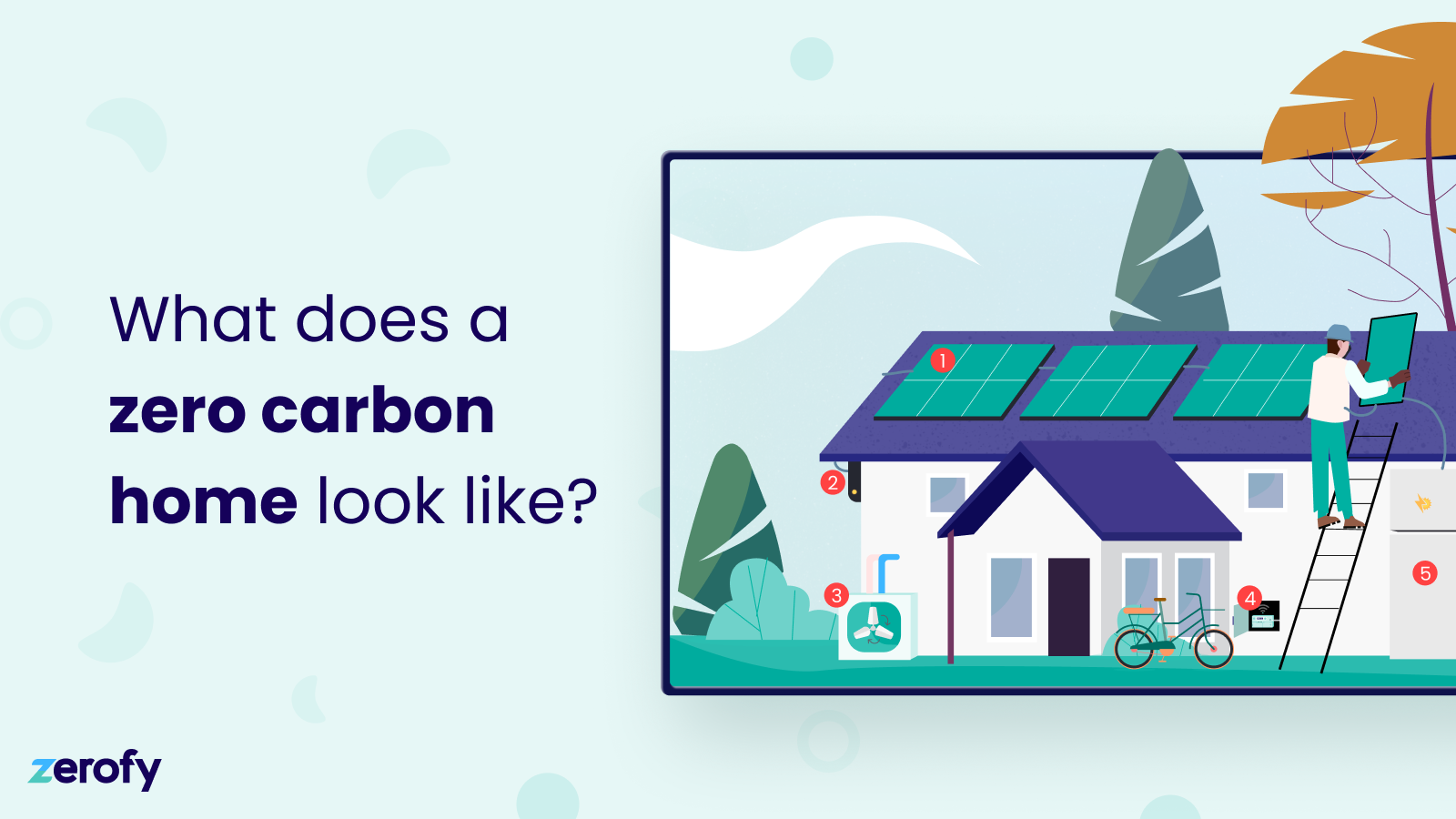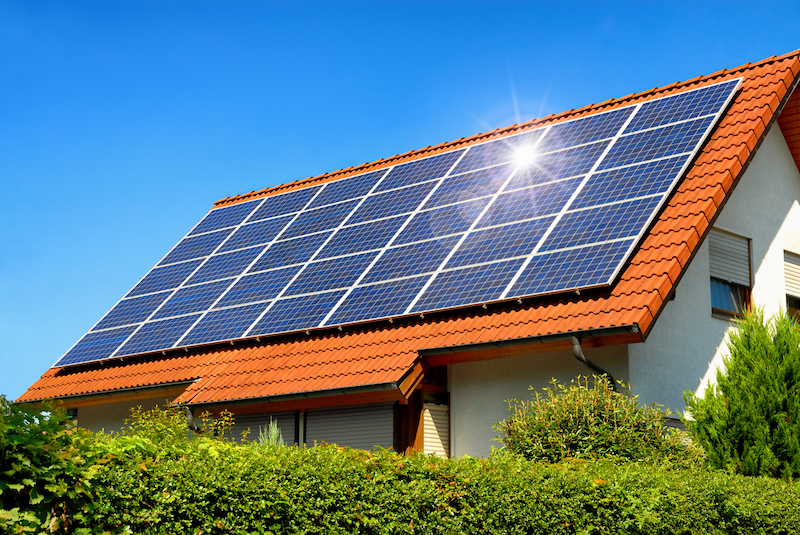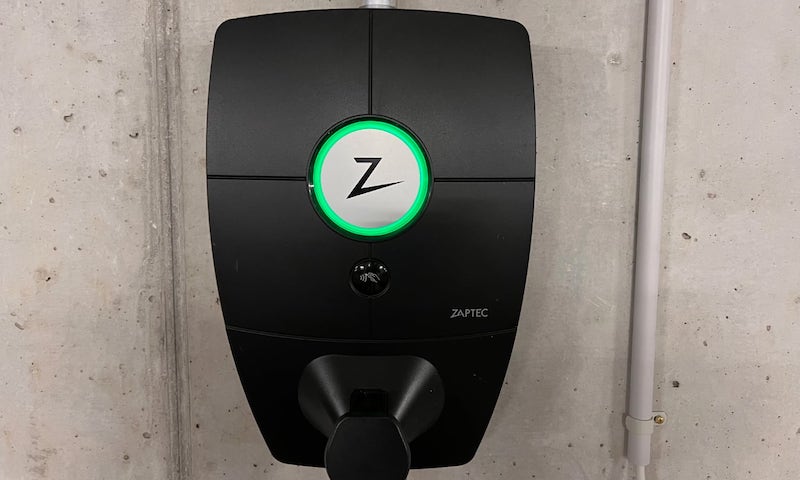
Zerofy’s vision is to help households become fully electrified to reach a zero carbon home with our app. It’s a vision we have built our app around, by bringing many different technologies that support the zero carbon home into one place.
A zero carbon home is one that does not produce any carbon dioxide emissions. In the current climate challenge, the concept of the zero carbon home is important: seventy percent of global greenhouse gas emissions can be indirectly attributed to households. By moving towards zero carbon sources of home heating and energy, transportation, food, and goods and services, households can play a key role in meeting global climate targets.
Achieving a zero carbon home is possible, especially when members of the household have access to innovative products and services, and good data. Various connected technologies also play a big role in managing and reducing energy use. Below, we’ve included what we see as the components of the fully electrified zero carbon home and expanded on how each factor contributes to our vision.
Components of a zero carbon, fully electrified home
Rooftop Solar
How solar contributes: helps households increase the amount of their electricity that is renewable and zero-carbon, or if they solely rely on solar, can allow them to eliminate emissions from their electricity usage.
Solar electricity production is the process of harnessing sunlight to create renewable electricity. Solar is a key part of decarbonisation of both residential electricity and the energy system as a whole. When a household installs solar panels, they become energy producers, thereby becoming more independent, protecting against high electricity prices, and even earning money if they sell their electricity back into the grid. If you live in a home where you aren’t able to install solar panels, or have exceeded your capacity, check out Shared Solar.
Further reading: How much electricity does a solar panel produce? A summary of key facts for solar

Credit: iStock
Solar inverter
How solar inverters contribute: they are a key part of a home solar set-up because they allow the solar energy you’ve generated to become usable in the home.
A solar inverter is a type of power inverter that makes it possible to power your home’s electricity with solar. Houses are wired to operate on AC (alternating current) power. If you have solar panels and want to use the DC (direct current) energy you have produced, you need a way to transform it to AC. In addition to transforming the power for use, solar inverters are also the primary mode of connecting your solar panels with your home’s electric panel (Source: Wikipedia).
Home batteries
How batteries contribute: allow households to maximise self-consumption of the produced green electricity by storing it for off-peak production.
For some households, their solar set-up may produce more electricity than they can use during the day. And in some countries, there is very minimal compensation for feeding solar electricity into the grid, especially at solar peak times. Home batteries can be used to store this excess electricity generated from solar panels for later use, namely at night. This means they can be used by households to maximise the consumption of their own generated electricity. By using batteries, you can become less dependent or even independent of the grid.
Further reading: How to choose a home battery for energy storage
Electric vehicles
How electric vehicles contribute: since electric vehicles run on electricity as opposed to fossil fuels like gasoline or diesel, their associated emissions are much lower.
Owning an electric vehicle is a powerful way to reduce the carbon footprint of your household’s mobility activities. For example, the lifecycle greenhouse gas emissions of an average vehicle in the EU is 258 gCO2e per kilometer, with 64% of those emissions coming from the tailpipe. In comparison, the lifecycle greenhouse gas emissions of a 2019 Nissan Leaf in the EU is 109 gCO2e per kilometer (Source: Carbon Brief) when powered with grid electricity. The emissions savings of driving electric with grid electricity can be enhanced by choosing to charge your electric vehicle at times when the carbon intensity is low.
When electricity for the vehicle comes from a low-carbon energy mix, the emissions continue to fall. For example, a Nissan Leaf’s emissions could be as low as 31 gCO2e per kilometer (Source: Sustainability by Numbers). If your household uses your own solar electricity to charge your electric vehicle, or from another low-carbon electricity source.
Further reading: Three great and small electric vehicles
Wallbox EV charger
How wallbox EV chargers contribute: they allow you to securely charge your EV at home, thereby using the electricity from your own solar panels or home battery, or just having more control over choosing charging times with low carbon intensity and electricity prices.
Despite its name, a wallbox EV charger is actually not a charger, but instead a device that can feed AC to your electric vehicle. When a wallbox is being used, a vehicle onboard charger is converting AC to DC. In contrast, at roadside, DC fast charging is the more powerful charging electronics located in the fast charging cabin. The electrons flowing to the charging cable are already in DC mode.
Further reading: Wallbox EV chargers: How to choose the right one

Smart meter
How smart meters contribute: better understanding and precise data on electricity usage so households can make reductions, plus more control for energy consumers who are also producers. A conventional meter logs how much electricity and gas a household or business uses. They are usually read out manually by your utility company (for example monthly, or in some cases even only twice a year), which is then used to calculate your bill. A smart meter is similar in that it logs energy use. It differs significantly however, in the insights and data it can provide. A smart meter records the electricity use of your household and can store and transmit it digitally (for example to your utility company). You can access this data and have granular electricity usage right at your fingertips to make the best decisions possible.
Further reading: What are smart meters? How they help save money money and reduce emissions
Heat pump for space heating
How heat pumps contribute: they use less electricity to do the same amount of work as electrical resistance heaters. And of course they are avoiding inefficient fossil fuel heating with oil or gas.
A heat pump is an electrical device that can heat and cool your home. Heat pumps work by taking energy from a low temperature environment and transferring it to a higher temperature environment. They allow you to be able to heat (and cool!) your home with higher efficiency and therefore fewer emissions produced.
Most heat pumps nowadays have an app for adjusting the temperature and setting working times remotely. Some even have connectivity that controls the heat pump based on electricity spot prices. If prices correlate with CO2 emissions, it means you can program your heat pump to operate during the cheapest and greenest hours.
Heat pumps can also be used to preheat the space with surplus solar electricity. The space is just heated a little bit “in advance,” and the stone and wood of your house stores the heat and radiates it for hours after, effectively functioning as energy storage.
Further reading: Heat pumps 101: How they work and emissions reducing capabilities
Electric boiler and heat pump heating with a boiler
How electric boiler/heat pump heating with a boiler contributes: more efficiently produces the hot water needed for a household.
Heating water with conventional resistance water heating boilers can be improved by heating water with heat pump water heaters or heat pumps with integrated water tanks. Heat pump water heaters are similar to conventional water boilers but have an integrated miniature heat pump unit. In climates where space heating is not needed, it is a very efficient way to produce hot water. In very cold climates, it might not be the best mechanism to use as the device cools down the room where it is located and in the winter this is mostly not advisable (Sources: EnergyGov, Leafscore).
When space heating is also needed, ground source and air to water heat pumps can also produce hot water very efficiently. Ground source heat pumps have compact units where the water tank is integrated into the main unit (Source: Nibe).
Water in tanks (either produced by electrical heaters or heat pumps) is also acting as an excellent and inexpensive energy storage option to shift the daily solar energy to cover evening or next morning hot water consumption.
Further reading: how to track and understand your home electricity usage
Modern and smart appliances
How smart appliances contribute: give you greater control and insight into your energy use for lowered usage and associated emissions.
Smart appliances are those that can be connected via wifi to a smartphone, tablet, or computer for enhanced control, information, and programming capabilities. When used effectively, smart appliances can save your household energy, reduce emissions, and lower utility bills.
One example of a smart appliance that can reduce your carbon emissions is a smart thermostat. Even though you can manually adjust the temperature of your home, installing a smart thermostat automatically regulates the temperature, keeping your home more energy efficient. Smart thermostats often mean greater control, more comfortable homes, and even savings. Smart thermostats use wifi to connect with an app on your smartphone. Then, you can schedule and program when your heating or cooling turns on, and at what temperature. For example, you could program your home heating to drop by three degrees when your family is asleep, say between 10 pm and 7 am, and then increase at 7 am once everyone is awake.
Further reading: How to save money, energy, and CO2 on clothes washing and drying
Smart plugs
How smart plugs contribute to a zero-carbon home: they help your household understand the electricity use of various appliances, and program them in ways that can save electricity (and money!). Your household can avoid using electricity unnecessarily to power appliances.
A smart plug is a device that fits in between the power socket in your wall and an appliance. They are similar in appearance to power adapters you may have used when traveling. The reason they get the ‘smart’ moniker is because these plugs allow you to control the appliance they’re plugged into remotely, enabling them to function in more environmentally efficient and useful ways.
The majority of smart plugs work by connecting to wifi, and then are controlled by an app or through a smart home hub, like Amazon Alexa, Google Home, or Apple Homekit. This means you’ll be able to remotely control the power going into your connected appliances, and set up automated actions. Every appliance that you have connected to a smart plug can then be visible and controllable from one place.
We have a comparison of smart plugs on our website, and our top picks are the MyStrom Switch and the Shelly Plug S, which you can get directly in our shop.
Further reading: What is a smart plug?
How these components come together in the Zerofy app
All of these appliances, devices, and technologies are valuable for reducing emissions on their own and represent a great step in the right direction. Where they really make an impact however, is when they are connected in one central place. The Zerofy app can connect to many different appliances, devices, and also takes into consideration components (like heat pumps and electric vehicles) when automatically tracking your emissions. This is powerful in working towards a zero carbon household because it gives you the most accurate picture possible of your household’s energy and transportation-related emissions. The information will be automatically pulled in so you won’t need to worry about manual entry. You’ll be able to see a breakdown of your emissions across categories, devices, and durations of time, and make changes based on this info to reduce. Plus, the Zerofy app provides custom recommendations and guides on how you can reduce emissions, based on your household.
Get Started Today